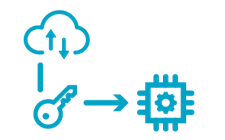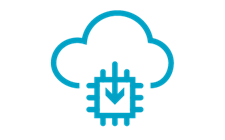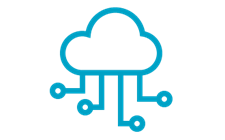Why device management
Any IoT device fleet must be managed throughout its lifecycle, to ensure continuous monitoring, effective and secure operation, and adequate maintenance and updates. nRF Cloud Device Management is Nordic's answer to this challenge, as we are uniquely positioned to offer a turn-key chip to cloud device management solution out-of-the-box.
We provide customers with the most energy-efficient device management cloud solution, tightly integrated with Nordic silicon and software. Our offering enables customers to accelerate their time-to-market, and scale their IoT fleet management cost-effectively.
These are the key reasons why device management is a must have for IoT deployments:
- Lifecycle Management: Throughout the lifecycle of an IoT device, from provisioning to retirement, various management tasks are essential – data, operations, FOTA updates
- Security: Encryption, authentication, access control, and regular security updates to protect devices and data from unauthorized access and attacks
- Performance: Identifying and addressing performance issues, ensuring devices operate at their full potential, and enabling updates/adjustments as needed
- Scalability: Managing devices as fleet is mandatory and certain operations should be always done for masses of devices simultaneously
- Regulatory & Compliance: Ensure compliance by enforcing policies, maintaining audit trails, and facilitating reporting and documentation as needed
nRF Cloud Device Management enables operational decoupling and IoT data-as-a-service model. It integrates seamlessly into your existing processes and systems and acts as the single entry-point for all device data, scaling across different devices and applications. Operational data (e.g. battery level, temperature) can be handled by the company operating the IoT device, and application data (e.g. trash container fill level) can be handled by the company consuming the data to drive their operations.
Benefits of device management
Cost savings
Easy adoption of any device management feature stand-alone allows you to create a tailored service bundle that meets your needs.
Time-to-market
Device management is ready to go out-of-the-box on both cloud and device side by leveraging the nRF Cloud libraries on our nRF Connect SDK, abstracting away the connectivity details and offering a faster development path. The FOTA capabilities also allow you to accelerate your manufacturing schedule and release software updates to devices already on the field.
Scalability
nRF Cloud Device Management grows with your business. From a few devices on a pilot run to thousands of devices on a production deployment, we have your back.
Future-proof
Extend the lifetime of your devices on the field by keeping them optimized, secure and updated.
nRF Cloud Device Management

Onboarding
Onboarding is the process of security connecting and registering a device to nRF Cloud Device Management. There are different onboarding methods:
- Auto-onboarding: Automatically onboards devices during secure provisioning process (claimed device)
- Preconnect: Add devices before first connection using CA certificates

Configuration
Enables modifying the device's state and parameters to ensure optimized operation. This is an essential capability for devices without user interaction that only interface with the cloud (smart cities, asset tracking).
- Always available: The device does not need to be online to check its latest reported state, nRF Cloud has a digital representation (shadow) of the device at all times
- Filtering and grouping: Server-side metadata allows grouping devices so that it’s possible to filter and find specific devices and groups
- Device state snapshot: Always know the device’s latest reported configuration (what is in the device) and set the desired configuration (what should be in the device)
- Shadow Delta: Device can ask for full configuration or delta configuration (desired vs reported) to get only latest changes, saving energy and data costs
- Shoot and forget: Update the desired configuration at any time and the device will get updated upon the next connection

Monitoring
Monitor the status of your entire IoT fleet or individual devices and quickly react to issues to maximize operational uptime.
- No cloud development: Cloud side implementation is ready to go, just start monitoring alerts from your IoT fleet on nRF Cloud Portal
- Easy firmware development: nRF Connect SDK includes libraries to send alerts and leverages the logging framewor, so you can focus on your application
- Remotely configurable: Configure logging level remotely. For example, increase log level following an alert to get more details, and decrese it when resolved to conserve energy
- History: Alerts and logs are stored in nRF Cloud for 30 days
- From fleet to device: Get a fleet-level overview of new alerts and drill to device specific alerts and history in the device details

Firmware-over-the-air (FOTA)
FOTA is an indispensable capability to ensure that your IoT devices in the field are future-proof.
- Accelerate time-to-market: Start manufacturing and shipping devices with a minimal feature set and deploy new features later to all devices operating in the field
- Full control: Update device groups or individual devices and manage multiple deployments for different targets
- Flexible and scalable: Start with a small test deployment, monitor progress and collect reports before a full rollout at scale
- Install with ease: Newly installed devices can be pre-programmed with any firmware version and automatically update to the latest upon first connection
- Enhanced security and longevity: Regular updates ensures your devices stay secure and functional for a longer period of time.
Data collect

IoT is fundamentally about the data
The devices on the field are an army of data collectors. Local processing can be efficient but it has limited scope, requiring data to be sent to the cloud so that it can be analyzed at scale, driving more value. Device management keeps IoT devices operation at their best to ensure the data continues to flow.
Data collect feature in nRF Cloud allows devices to send both operational and application data to nRF Cloud, utilizing a unified interface that ensures the lowest power and simplest implementation that abstracts away the connectivity details so that you can focus on your application logic.